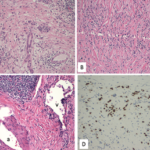 The ACR and the European League Against Rheumatism (EULAR) jointly endorsed the first classification criteria for IgG4-related disease (IgG4-RD), published in the January 2020 issue of Arthritis & Rheumatology. The criteria were authored by a steering committee representing a multispecialty group of 86 investigators from North America, Europe and Asia. The criteria were presented in draft form at the 2018 ACR/ARHP Annual Meeting in Chicago. The published criteria are a significant milestone for a disease that was recognized as a distinct condition only 15 years ago.
The ACR and the European League Against Rheumatism (EULAR) jointly endorsed the first classification criteria for IgG4-related disease (IgG4-RD), published in the January 2020 issue of Arthritis & Rheumatology. The criteria were authored by a steering committee representing a multispecialty group of 86 investigators from North America, Europe and Asia. The criteria were presented in draft form at the 2018 ACR/ARHP Annual Meeting in Chicago. The published criteria are a significant milestone for a disease that was recognized as a distinct condition only 15 years ago.
The criteria were developed primarily to identify patients for inclusion in clinical trials and other studies, and are not intended for diagnostic use in clinical practice. Strong emphasis was placed on achieving the highest possible specificity, with the result that some patients with clinical diagnoses of IgG4-RD, particularly those with disease that affects only organs infrequently involved in IgG4-RD, will not fulfill the classification criteria.
“If the appropriate clinical diagnosis for a patient is IgG4-RD, then failure to fulfill the ACR/EULAR classification criteria should not prevent the management of that patient’s condition accordingly,” the investigators write in the paper.
Multi-Organ Disease
Rheumatologists worldwide now recognize IgG4-RD as an immune-mediated, multi-organ disease that causes fibroinflammatory lesions with myriad clinical presentations. Although it is characterized by distinctive clinical, serological, radiological and pathological findings, IgG4-RD is often confused with malignancy, infection or other immune-mediated conditions, such as Sjögren’s syndrome, pancreatic cancer, granulomatosis with polyangiitis, giant cell arteritis or systemic lupus erythematosus. IgG4-RD tends to affect middle-aged to elderly individuals and often causes severe damage to the pancreas, making glucocorticoids a suboptimal therapy for this condition. IgG4-RD can affect virtually any organ, but it most often damages the major salivary glands, orbits and lacrimal glands, pancreas and biliary tree, lungs, kidneys, aorta and retroperitoneum, meninges and thyroid gland.
Generalists and specialists of every kind may see patients with IgG4-RD, but rheumatologists are the most likely specialists to treat these patients. “Rheumatologists are among the few medical specialists who have a great interest in multi-organ diseases,” explains John H. Stone, MD, MPH, director of clinical rheumatology at Massachusetts General Hospital, Boston, and co-author of the criteria.
Classification Criteria
The variable nature of IgG4-RD presentation means that no single set of classification criteria can include all patients with the disease. Likewise, although clinical, serologic, radiologic and pathologic features all contribute to the classification of IgG4-RD, none of these approaches alone allow for accurate classification of patients. For these reasons, the criteria use a multi-step process that incorporates data from all four domains to classify patients with IgG4-RD.
The criteria were evaluated using an international cohort of approximately 1,900 patients with either IgG4-RD or a mimicking condition. A derivation cohort included 486 patients, the first validation cohort included 908 patients and the second validation cohort included 485 patients. The criteria steering committee used a data-driven approach that included consensus exercises, existing literature and multi-criteria decision analysis to identify, weight and test potential classification criteria. The investigators first generated potential clinical, serologic, radiologic and pathologic items, then established definitions for the entry, exclusion and inclusion criteria.
The steering committee used the derivation cohort to assess the relative performance of 78 proposed exclusion and inclusion criteria and to eliminate criteria that did not distinguish IgG4-RD cases from mimickers. The investigators then used multi-criteria decision analysis to assign weighted point values to each remaining inclusion criterion.
The variable nature of IgG4-RD presentation means that no single set of classification criteria can include all patients with the disease.
Sensitivity & Specificity Analysis
Because many diseases can mimic IgG4-RD, it is important that the classification criteria have a high degree of specificity, Dr. Stone explains. The investigators found that a threshold of 20 points achieved a high level of specificity while maintaining acceptably high sensitivity. Tested on the first validation cohort, a threshold of 20 points had a specificity of 99.2% and a sensitivity of 85.5%. In the second validation cohort, the 20-point cutoff had a specificity of 97.8% and a sensitivity of 82.0%.
Dr. Stone notes that the sensitivity of the criteria is remarkable considering the many different manifestations of IgG4-RD. However, the authors recommend further evaluation of the criteria against specific populations enriched for malignant conditions, such as non-IgG4-RD pancreatobiliary diseases and infection.
Exclusion & Inclusion Criteria
The IgG4-RD classification criteria use a three-step process. The first is to demonstrate that a patient’s disease involves at least one of the 11 organs most often affected by IgG4-RD: pancreas, salivary glands, bile ducts, orbits, lacrimal glands, kidneys, lungs, aorta, retroperitoneum, pachymeninges or thyroid gland (Riedel’s thyroiditis).
The second step is evaluating the exclusion criteria. The IgG4-RD classification criteria are the first ACR/EULAR criteria to include absolute exclusion criteria that are not based solely on having an alternative diagnosis, according to Dr. Stone, due to the many potential mimickers of IgG4-RD. When the steering committee applied the exclusion criteria, they found specificity improved by 10%.
The exclusion criteria for IgG4-RD include 32 clinical, serologic, radiologic and pathologic features, including recurrent fever without infection, rapid radiologic progression and prominent neutrophilic inflammation. The presence of any of these features eliminates the patient from IgG4-RD classification. Fever is rarely a primary presentation of IgG4-RD, Dr. Stone notes, and failure to respond to steroids suggests the patient does not have IgG4-RD. The exclusion criteria also direct rheumatologists to examine serum for the presence of antibodies that may indicate a different diagnosis. The exclusion criteria are not intended to serve as a checklist, but instead remind investigators to consider other evaluations appropriate to the clinical presentation.
The third step is the application of eight, weighted, inclusion criteria domains that address clinical findings, serologic results, radiologic assessments and pathology interpretations. As noted above, a sum of at least 20 points from these inclusion criteria yielded very high specificity and moderately high sensitivity.
Using the Criteria
Importantly, rheumatologists should understand that a patient does not have to have an elevated IgG4 serum concentration to be classified as having IgG4-RD, Dr. Stone explains. Serum IgG4 levels are normal in a substantial percentage of patients with clinicopathologic diagnoses of IgG4-RD. Elevated IgG4 gives four points toward classification but must occur in combination with other features to reach the threshold. More important are radiologic findings consistent with IgG4-RD, such as a sausage-shaped pancreas and periaoritis affecting the infrarenal aorta.
The criteria were designed to imitate the path clinicians will take toward diagnosis, Dr. Stone explains. As such, they do not require a biopsy for classification of IgG4-RD. Most of the patients assessed in the study did have biopsies, but biopsy data were primarily used for exclusion. However, a closer examination of the false-negative cases in the validation cohorts revealed the majority of these patients fell short of the 20-point cutoff because they were less likely to have had biopsies compared with true-positive cases.
As research in IgG4-RD advances, rheumatologists will likely lead most of the clinical trials investigating targeted treatments for IgG4-RD that can spare patients from the toxicities of conventional treatments. The new classification criteria will allow rheumatologists to accurately identify patients for inclusion in clinical, epidemiological and basic investigations and are already being used as entry criteria for clinical trials.
Lara C. Pullen, PhD, is a medical writer based in the Chicago area.


